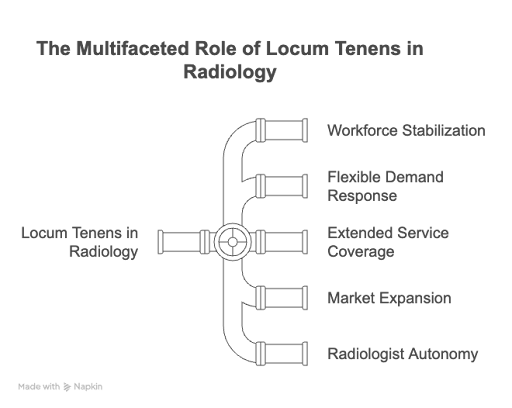10 Unignorable Trends in Teleradiology Recruiting for 2025
You’ve probably heard that teleradiology is just a temporary fix for the shortage of radiologists. It’s not.
The rise of teleradiology has reshaped the field of radiology and become a core pillar of patient care across hospital settings, academic centers, and private practice.
Healthcare institutions are now investing heavily in advanced imaging technology, remote diagnostic radiologists, and flexible work schedules to meet the growing demand for imaging services.
This article breaks down 10 key trends that are actively shaping the future of radiology recruiting in 2025.
What Exactly is Teleradiology?
Teleradiology is the practice of interpreting radiological images, like X-rays, CT scans, and MRIs, remotely, using secure digital platforms.
Instead of being onsite at a hospital or clinic, a diagnostic radiologist can review and report on cases from anywhere in the world. These images are transmitted electronically from the healthcare facility to the teleradiologist, who then delivers a diagnosis that informs patient care.
This model helps healthcare providers manage the growing demand for imaging services, especially in areas with a shortage of radiologists. Teleradiology solutions also support academic centers, private practice groups, and hospital settings by offering scalable coverage, subspecialty expertise, and faster turnaround times, without compromising diagnostic accuracy or quality of care.
Why is Teleradiology so Important?
It solves the rural care gap that no hospital wants to talk about. Many healthcare facilities in underserved areas can’t recruit full-time diagnostic radiologists. Teleradiology providers close that gap by giving them 24/7 access to radiological services without local staffing.
It’s not just about convenience, it’s about diagnostic accuracy at scale. Advanced radiology practices draw on subspecialty expertise (like breast imaging or interventional radiology) from anywhere, which improves accurate diagnosis across a wide range of cases that local generalists can’t always interpret.
The radiology workforce is shrinking and teleradiology is how we stay ahead. With the ongoing shortage of radiologists, the only scalable solution for healthcare institutions is outsourcing to teleradiology companies that can flexibly meet demand.
It gives private radiology practices a competitive differentiator. Private practice groups use teleradiology solutions to extend after-hours coverage and prevent burnout among medical professionals.
It’s how healthcare providers can offer flexible work schedules without sacrificing quality of care. Teleradiology allows radiology professionals to work remotely, which is now a major driver of retention, especially among locum tenens Radiologists and those who want a better work-life balance.
Teleradiology is becoming the foundation for new business models in radiology. From private equity-backed rollups to hybrid academic-private setups, the teleradiology market is now a core part of evolving payment models and radiology business strategies.
It’s the entry point for AI and automation in imaging workflows. Many key players in the teleradiology sector are early adopters of artificial intelligence for triage, interpretation support, and operational efficiency, putting them at the forefront of the future of radiology.
What Does a Great Teleradiologist Look Like?
Hyper-focused on diagnostic accuracy, even without in-person cues. A top-tier teleradiologist delivers accurate diagnoses from radiological images without relying on physical patient context, using meticulous attention to detail and clinical correlation.
Thrives in a fully digital, high-pressure environment. Unlike traditional roles in hospital settings, teleradiology demands speed and precision within a fully virtual workflow, especially when handling high volumes or urgent reads across time zones.
Communicates clearly with a wide range of healthcare professionals. Great teleradiologists don’t just send reports, they engage with healthcare providers, emergency physicians, and specialists to clarify findings and guide patient-centered care.
Understands the complex landscape of radiology practices. Whether working with academic centers or private equity-backed radiology companies, they adapt to different business models, teleradiology solutions, and teleradiology provider standards.
Adopts cutting-edge technology without hesitation. The best radiology professionals actively use advanced imaging technology, AI-supported workflows, and PACS/RIS systems to improve turnaround time and efficiency.
Balances autonomy with team awareness. Even in remote roles, top teleradiologists align with the goals of the healthcare institution or private practice they support and maintain high standards in quality of care.
Flexible, but never inconsistent. They manage flexible schedules or locum tenens rotations while delivering consistent performance, a trait that's increasingly important in today’s radiology workforce dynamics.
10 Unignorable Trends in Teleradiology Recruiting for 2025
1. Clinical Subspecialists Are the New Gold Standard
Hiring in 2025 is laser-focused on subspecialists, and for good reason. The teleradiology sector is managing an explosion in image volume and complexity, particularly in cases where high diagnostic accuracy is non-negotiable. Healthcare providers increasingly seek radiologists trained in breast imaging, interventional radiology, and neuroradiology to interpret complex radiological images across a wide range of use cases.
Subspecialists can offer more nuanced reads, reduce error rates, and provide value that general radiologists, despite strong foundational skills, often cannot match in high-acuity cases. Subspecialized expertise can boost a radiologist’s average base salary by 7–11% compared to generalists. For example, interventional radiologists earn on average 11.3% more than non-subspecialized peers.
The graphic below shows the advantages of hiring subspecialists:
The implications for hiring executives are clear: generalists are no longer enough to remain competitive in a field where diagnostic complexity is rising and healthcare providers demand specialization. Teleradiology providers need to rethink their recruiting funnels, compensation models, and retention strategies to attract this elite tier of radiology professionals.
2. AI Literacy Is a Screening Requirement
In 2025, a great radiologist isn’t just clinically strong, they’re also digitally fluent. Teleradiology providers now expect candidates to be comfortable working with artificial intelligence tools that support triage, prioritization, workflow optimization, and even reporting assistance.
AI isn’t replacing radiologists, but it’s rapidly becoming a partner in delivering accurate diagnosis at scale. That shift means hiring executives must now evaluate not only medical credentials, but also digital adaptability, especially in advanced radiology practices where AI is embedded across the imaging pipeline.
The image below shows how AI is shaping radiologist careers:
Radiology Partners recently reported that more than 2,600 of their 3,600 radiologists were using at least one AI tool in their workflow.
Tools like Aidoc, Viz.ai, and Zebra Medical are now considered standard in many high-volume teleradiology settings, as they help flag critical findings like pulmonary embolisms or intracranial hemorrhages before human review.
For hiring managers, this means screening for AI literacy is no longer optional. Some teleradiology companies have begun assessing candidates through workflow simulations involving AI-supported platforms. Others explicitly include AI familiarity as a requirement in job postings. In a complex landscape where speed, accuracy, and scalability are everything, the ability to work alongside artificial intelligence has become a defining skill for the modern diagnostic radiologist.
3. Private Equity-Owned Groups Are Scaling With Recruiter Playbooks
Private equity is aggressively rewriting the rules of teleradiology recruiting. Firms like Radiology Partners, one of the largest private equity-backed radiology groups in the U.S., are building scalable recruitment engines driven by metrics, efficiency, and standardized onboarding. As of December 2023, about 12% of all U.S. radiologists (4,071 out of 34,853) were employed by private equity-backed entities: a dramatic increase from just 1% a decade earlier.
These firms don’t rely on traditional academic pipelines or passive referrals; instead, they deploy dedicated recruiting teams, software-driven applicant tracking systems, and structured playbooks that can identify, vet, and integrate radiology professionals faster than legacy healthcare institutions. The graphic below highlights this difference:
For hiring executives competing in the same talent pool, this trend is both a warning and a playbook. Private radiology groups and teleradiology providers that fail to modernize their recruitment pipelines, particularly in a market affected by the ongoing shortage of radiologists, will continue to lose top-tier talent to more agile, private equity-backed competitors.
4. Asynchronous Work Is the Competitive Differentiator
In 2025, flexibility isn’t just a perk, it’s a recruitment strategy. More and more teleradiology providers are shifting away from real-time, on-call reading models and toward asynchronous work structures.
This model allows radiologists to interpret studies during their own local daytimes, even if the imaging was performed overnight elsewhere. The result is a win-win: healthcare facilities maintain 24/7 coverage, while radiology professionals avoid the chronic fatigue and burnout associated with traditional overnight shifts. Check out the graphic below for a visualization of these benefits.
Leading companies like Everlight Radiology have adopted a global distributed workforce model, intentionally hiring radiologists across different time zones to allow overnight reads for one region during daylight hours in another. This asynchronous model is a highly efficient competitive differentiator in the teleradiology sector’s talent wars.
Hiring executives who fail to promote asynchronous opportunities may find themselves outpaced by key players offering greater work-life balance. As the radiology workforce continues to demand autonomy and scheduling flexibility, asynchronous models will define not just productivity but also employer brand strength and retention success.
5. Locum Tenens Is No Longer Temporary: It’s Strategic
Historically viewed as short-term solutions, locum tenens radiologists have become essential long-term assets in the teleradiology sector. In 2025, healthcare institutions and teleradiology providers are intentionally integrating locum tenens professionals into their staffing models, not as emergency backups, but as a proactive strategy to stabilize workforce dynamics and prevent physician burnout. This shift allows facilities to respond flexibly to fluctuating demand for imaging services, seasonal volume surges, or unexpected vacancies without compromising the quality of care.
Radiologists rank third among specialties most engaged with locum tenens opportunities, behind anesthesiology and emergency medicine, reflecting growing acceptance of these roles in radiology.
Teleradiology companies are also using locum tenens strategically to extend 24/7 service coverage, trial new markets, and offer flexible schedules that appeal to radiologists seeking autonomy.
In the image below you can see the benefits of locum tenens in radiology:
For hiring executives, this trend means rethinking how locum relationships are structured. Rather than focusing solely on short-term credentials and rapid onboarding, forward-thinking organizations are building long-term engagement plans for locum tenens radiologists, including professional development, consistent scheduling, and even partial benefits, to retain these high-impact professionals across long cycles.
6. Global Talent Pools Are Now Actively Tapped
In 2025, the shortage of radiologists in the U.S. is pushing teleradiology companies to widen their recruiting lens globally. By 2033, the U.S. could face a shortage of up to 42,000 radiologists, with nearly half of current radiologists at retirement age and imaging studies increasing by up to 5% annually, exacerbating the workforce gap.
Advances in remote credentialing, telehealth regulation, and interstate licensure compacts have made it far easier to onboard international diagnostic radiologists who meet U.S. standards.
For hiring executives, this means tapping into a previously overlooked supply of qualified medical professionals while maintaining compliance, diagnostic accuracy, and turnaround speed. The image below illustrates how this works:
For U.S.-based teleradiology providers, sourcing internationally is more than just a workaround, it’s a forward-facing workforce strategy. It addresses the shortage of radiologists, allows for 24/7 global coverage, and means healthcare facilities can provide access to quality care without being bottlenecked by regional staffing limitations.
7. Cultural Fit Is Assessed by Workflow Simulation
Teleradiology recruiting is no longer based solely on resumes and reference checks. Providers have embraced workflow simulations as a core part of the vetting process, replicating real case volumes, PACS environments, and report turnaround requirements to see how candidates operate under pressure.
68% of employers now use skills tests in the hiring process, but these workflow simulations aren’t simply skills tests; they’re a window into how a radiologist fits into a group’s communication style, decision-making tempo, and quality expectations.
These assessments may include reviewing a timed set of anonymized radiological images, submitting structured reports using the provider’s actual reporting tool, or navigating a simulated queue to mimic real-world case prioritization. The image below shows how these assessments can complement traditional hiring methods:
For hiring executives, this trend solves two problems: it filters out candidates who can’t perform under real-world pressures, and it reveals who will thrive in the team’s workflow culture. Especially in a field as process-intensive as teleradiology, where volume, turnaround, and collaboration intersect constantly, this type of cultural vetting is proving to be a key differentiator when it comes to long-term performance and retention.
8. Academic-Private Hybrid Models Attract Top Candidates
Hybrid affiliations between academic centers and private radiology groups have become a powerful recruiting channel. These models blend the research prestige and structured learning environment of academic institutions with the compensation flexibility, workload autonomy, and operational agility of private radiology.
For teleradiology professionals, this hybrid format offers the best of both worlds, continuing education and career development without sacrificing income or schedule control. This has a high level of support — the majority of radiologists in Europe support continued education while working.
In the graphic below, you can see the benefits of this kind of hybrid model:
For hiring executives, these hybrid models are a strategic way to retain top diagnostic radiologists, especially those who want subspecialty growth, academic collaboration, and a sustainable work-life balance. As more radiology professionals demand meaningful work paired with flexible schedules and strong compensation, this model is fast becoming a competitive differentiator.
9. Flexible Work Schedules Are Negotiated Upfront
Flexibility in scheduling in 2025 has become a baseline expectation. Radiology professionals, especially those in the teleradiology sector, now treat work-life balance as a core negotiating point.
Instead of adapting to fixed shifts, candidates expect customized coverage windows that fit their personal and professional lives. Teleradiology providers who don’t proactively offer flexible models risk losing top talent to competitors that have invested in adaptive scheduling systems and global coverage infrastructure. Check out the benefits of offering flexibility below:
Research found that 68% of radiologists ranked flexible scheduling as an important factor when looking for a new job. Hiring executives need to adapt to this reality. Today’s radiology workforce is more mobile, more selective, and more aware of burnout risks. Companies that offer flexible work schedules up front, rather than as a post-offer concession, are more likely to close hires quickly and retain them long term.
10. Employer Branding Is Now a Must-Have Strategy
In 2025, teleradiology companies aren't solely competing on salary, they’re competing on brand. Radiologists want to work for employers that represent more than just volume and efficiency. They’re seeking alignment with values like access to quality care, adoption of cutting-edge technology, support for patient-centered care, and genuine investment in workforce well-being.
Generally speaking, a strong employer brand can cut recruiting costs by as much as 50%. As a result, top firms are building visible, strategic employer branding efforts that signal these priorities to the market through career pages, social media, reputation on review platforms, and participation in academic and industry events.
The graphic below expands on a few benefits of strong employer branding in teleradiology:
For hiring executives, this is no longer optional. In a complex landscape defined by workforce shortage and fierce competition, employer branding is now an operational advantage. Building a clear, attractive employer identity can reduce time-to-hire, increase candidate quality, and improve retention in the long term.
Common Challenges When Recruiting Teleradiologists
Hiring for teleradiologist roles comes with some specific challenges and common pitfalls. Let’s take a look at a few of these, along with how to avoid them.
1. Overlooking Subspecialty Alignment
Mistake: Hiring generalists for roles that require subspecialty expertise.
Why it matters: Teleradiology workflows often involve complex reads in breast imaging, neuro, or interventional radiology. Mismatching skillsets leads to delays, escalations, and compromised diagnostic accuracy.
How to avoid it: Build role-specific pipelines. Use intake forms and credential screening tools to make sure your diagnostic radiologists are matched to the right types of cases.
2. Failing to Assess Tech Proficiency Upfront
Mistake: Assuming candidates are proficient with PACS systems, voice recognition software, or AI-integrated workflows.
Why it matters: Teleradiology is fully digital. Poor tech adaptation slows turnaround time and frustrates healthcare providers that rely on fast reads.
How to avoid it: Include workflow simulations and mock case reviews during the interview. Check for past experience with specific tools like Nuance, Aidoc, or internal reporting systems.
3. Undervaluing Flexibility During Offer Negotiation
Mistake: Offering fixed shifts or rigid overnight coverage models without asking for schedule preferences.
Why it matters: Flexible work schedules are a high demand. Ignoring this leads to offer declines or early attrition.
How to avoid it: Discuss shift preferences during the first call. Design modular, personalized coverage templates that scale with demand.
4. Credentialing Bottlenecks
Mistake: Underestimating the time it takes to license, credential, and onboard multi-state or international hires.
Why it matters: Credentialing delays can cost contracts and hurt service continuity for healthcare institutions.
How to avoid it: Use credentialing partners that are familiar with the Interstate Medical Licensure Compact (IMLC). Start credentialing during the offer stage, not after.
5. Generic Employer Positioning
Mistake: Marketing the role like any other clinical job without addressing what makes your teleradiology provider unique.
Why it matters: Top candidates have options. If your brand doesn’t highlight quality of care, cutting-edge technology, or cultural values, they’ll go elsewhere.
How to avoid it: Build a dedicated careers page. Share testimonials from current radiology professionals. Showcase your scheduling model, tech stack, and patient-centered care philosophy.
How to Approach Teleradiology Recruiting in 2025
Teleradiology recruiting in 2025 demands precision, speed, and strategic positioning. If you're still relying on outdated workflows, generic job posts, or rigid scheduling, you're losing the battle for top talent.
Adapt now: prioritize subspecialists, assess for AI fluency, and brand your company like it matters. The shortage of radiologists isn’t going away, and your approach to hiring will determine whether you lead or lag behind.
Start applying these trends before your competitors do.














![7+ Ways to Recruit Top Radiologic Technologists [+ Keep Them Long-Term]](https://images.squarespace-cdn.com/content/v1/65bd0965904e7e695a70ed54/1747777009272-442QFSWL3OQRW12FTHRB/7%2B+Ways+to+Recruit+Top+Radiologic+Technologists+%5B%2B+Keep+Them+Long-Term%5D.jpg)






